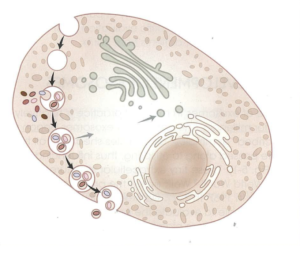
What are Exosomes?
Exosomes are membrane-bound extracellular vesicles (EVs) that are produced in the ENDOSOMAL system of cells of most eukaryotic cells.
Exosomes are formed through the inward invagination ((turns inwards) of a late endosome, also known as a multivesicular body (MVB) that encloses extracellular material.
MVBs contain intraluminal vesicles (ILVs) within them, which are formed by inward budding of the endosomal membrane. These ILVs are subsequently released from the MVBs into the extracellular environment as exosomes.
If the MVB fuses with the plasma membrane , these ILVs are released as exosomes.

Exosomes are derived from various cell types and are found in most bodily fluids Eg CSF, blood, saliva . They are also released in vitro by cultured cells into their growth mediums.

How do Exosomes work
They are spherical, tiny structures with diameters of only 30 – 149 nm. Thei tiny size enable evasion from phagocytosis by macrophages, increasing the likelihood of success of cargo transportation.
Exosomes are involved in transporting proteins, lipids, and genetic material such as RNA and DNA, between cells ie intercellular Communication. Most contain mRNA, miroRNA, small interfering RNA (siRNA)and over 4000 proteins including Annexins, flotillin, heat shock proteins (HSP70), phospholipids and lipid structures.
To summarise : Exosomes transmit miRNA,mRNA, siRNA and over 4000 proteins and lipids to induce regional cell signaling via the Paracrine system.
Cell signalling
The EXACT mechanism of action of exosomes is VERY complex. However, current understanding is action through four basic signalling mechanisms:
- Endocrine (hormonal) system
- Autocrine
- Juxtacrine
- Paracrine
For means of illustration , the most relevant patheay for aesthetic medicine is : the Fibroblast growth factor (FGF) pathway .
In this pathway, four stimulatory ligands will bind to a receptor of a regional cell:
- Fibroblast growth factor (FGF)
- Epiderma growth factor (EGF)
- Placental Groeth factor (PGF)
- Sarcoma Growth Factor (SGF)
Phosphorylation of kinase will automate the receptor Tyrosine Kinase (RTK) pathway.
Other Paracrine pathways include the Hedgehog family, four types of Wnt pathways, the JAK-STAT family and Transforming Growth Factor beta (TGF- beta)
I hope this illustrates amply the IMMENSE COMPLEXITY of how exosomes actually function !
Exosomes Usage in Aesthetic Medicine
<Table 5-1 : “Uses of Exosomes in Aesthetic Practice” > of Regenerative facial surgery
- Proteins
- signaling molecules
- enzymes
- genetic material, which influence the behavior and function of the recipient cells.
This cargo transfer allows cells to communicate and coordinate their activities, playing a role in various physiological and pathological processes, including immune responses, tissue regeneration, and cancer progression.
History of Skin Boosters
Gen 1: HA + Peptide cocktails
– skin hydration + collagen stimulation
Gen 2: PDRN / PN = salmon DNA
- supply the necessary RNA for cell renewal
- collagen stimulation, cell regeneration and DNA repair, anti-inflammatory and Cell-cell communications
Gen 3: Skin booster using Exosomes
Delivery methods: Topical , skin roller , enhanced by no pain MesoInfini
(electroporation, ultrasound) to increase penetration
Exosomes in Aesthetic Medicine

Effects of Exoxe
- Anti-inflammatory
- Antioxidant
- Regenerative
- Whitening